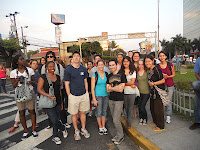It is difficult to know where to start because we have been so busy, constantly moving and going from one meeting to another, from one historic site to another, from one location of tragedy to another.
 |
| Swimming in Rio Sapo |
We spent last night at the Rio Sapo preserve which our guide, Serafin, said is in the middle of an ancient volcano. This seems quite possible since the entire area was made up of basalt outcroppings which are the extrusive form of lava flows. The students stayed in tents while the adults stayed in a cabin. I woke up a couple of times in the middle of the night and it was blissfully quiet, no roosters crowing or dogs barking or traffic. We had to hike into the camp about 45 minutes so we were hot and sweaty so the best part was swimming in the Rio Sapo which was quite warm and refreshing.
Our guide, Serafin, was also a former guerilla fighter for the ERP, one of the armies that formed the FMLN. He told us about his time as a soldier starting at the age of 11 years old. He was part of the intelligence and counter-intelligence division of the ERP.
 |
| Serafin talking around the campfire |
One of their biggest successes was setting a trap for General Monterosa in 1984 who was responsible for the massacres at El Mozote and elsewhere. He was considered a highly professional soldier by the US military. He was trained at the School of the Americas and was implementing a “scorched earth” policy or also what was known as “depriving the fish of water.” This term refers to the policy of eliminating the civilian population (water) through genocide and massacres and dislocation so that the insurgent guerilla forces (fish) have no one to support or hide them.
The ERP was successfully broadcasting Radio Venceremos (We Shall Overcome) throughout the war to publicize their victories and message to the people and the Salvadoran military was unable to locate them or their radio transmitter because they kept moving it. But the ERP heard that General Monterosa liked to collect trophies of war so they thought this might be an opportunity to entrap him.
They allowed word to get out through a known informant that the radio transmitter was going to be in a particular area at a particular time. They staged the area around the phony transmitter to look as though a battle had just taken place and the transmitter had just been abandoned. When the army found the transmitter, they immediately radioed back to General Monterosa for instructions. As the guerilla expected, he wanted to come and personally retrieve the radio transmitter. He brought a large contingent with him of journalists and even a priest in a separate helicopter so they could have mass to thank God for allowing them to have this victory over the guerilla of retrieving the transmitter.
Finally, when their celebrations and press conference was finished, the general loaded the transmitter into his helicopter and took off. Less than a minute into their flight, the guerilla exploded the bomb hidden in the phony transmitter. General Monterosa and his advisors were killed and this sent a shockwave through the Salvadoran and US military establishment because they had totally underestimated the creativity and capability of the guerilla.
 |
| The wreckage of Monterosa's helicopter |
Monterosa was responsible for the massacre of thousands of civilians, many of them family members of the ERP guerillas. So that night there was a celebration at his death, though many say that it was too easy of a death for him.
Paz y justicia,
Geoff








